Search results for 'Tubes for paint'
-
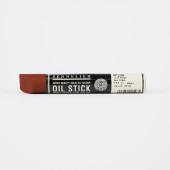
Sennelier Oil Sticks
Starting at: £7.65
Solid artists' quality oil paint sticks. (Ø = 3/4 ; length = 5" ) SENNELIER Extra-Fine Solid Oil Sticks can be used alone or in combination with oil colours in tubes. The oil stick colours can be used for an entire painting. They are applied directly to any traditional oil-painting support, such as canvas, wood panel or fine art paper. They need the same archival priming (acrylic gesso or oil ground) that oil paint requires. Surfaces: Before use, the surface film of the oil stick must be peeled off. It will form again after a few days of non-use, protecting and conserving the colour. The oil sticks must be applied in a thin film application of no more than 1mm thick. Once applied they can be painted over with oil stick or oil paint and if desired be diluted with turpentine. Oil stick Medium, a colourless oil stick, may be used to produce transparent effects and glazes. Once applied, the oil stick surface will dry in 2 to 5 days, depending on the atmospheric conditions Varnishing: If varnishing is desired, you must wait 6 months (as in traditional oil paint) until the colour is completely dry, before giving the painting a final coat of picture varnish. Use a soft brush to varnish so that the oil stick marks are not disturbed. SENNELIER Extra-Fine Solid Oil Stick colours are either opaque (O) or transparent (T) depending on the nature of the pigment in each colour. Oil Sticks do not change during storage and require no special precautions except to be kept away from any source of heat, which could adversely affect the stick. Application Techniques After applying the colour with the point or the edge of the oil stick, colours can be mixed directly on the support using the following methods: • Blending, with brush, finger, or drawing stump. With or without turpentine • Wash-drawing, dilute colours with turpentine or mineral spirit • Retouching, with oil stick, palette knife or brush • Textures, thick application oil stick colour. Retouch with a brush or palette knife •Sgraffito, scratching a layer of fresh paint with a point (brush handle, palette knife, etc.) to reveal the layer below. Sgraffito is related to engraving, and is used not only for revealing the under-layers of paint but also to scratch and clean unsatisfactory parts of the painting •Interior Decoration, on glass, ceramics etc. Use for decorative purposes only Learn More -
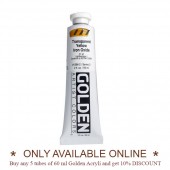
Golden Heavy Body Acrylic 59ml
Starting at: £11.70
The first acrylic colors offered by Golden Acrylic, Heavy Body paints are known for their exceptionally smooth, buttery consistency. The Heavy Body palette includes the largest assortment of unique pure pigments in a 100% acrylic emulsion available to professional artists. These colours offer excellent permanency and lightfastness. There are no fillers, extenders, opacifiers, toners, or dyes added. MULTI-BUY DISCOUNT Buy any five tubes of 59ml Golden Acrylic Heavy and get 10% discount. *Please note, this range is stored offsite. Please allow extra time for your order to be processed and dispatched. Learn More -
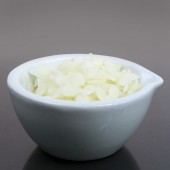
Bleached Beeswax
Starting at: £12.30
Beeswax is derived from melted honeycomb, and is available in two grades. Bleached Beeswax Pellets are white, having been bleached by the sun, and are an appropriate choice for using with pale colours, although they may revert to yellow over time. Natural Beeswax Pellets are yellow in colour, and offer a more flexible structure with a higher resin content. Beeswax has a melting point of 63-66°c, and may turn brown if over-heated. It is the most widely used wax in artists' materials, having a wide range of applications. Please see below for more details.
Learn More -
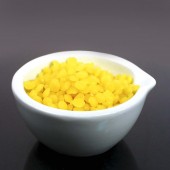
Natural Beeswax
Starting at: £11.20
Beeswax is derived from melted honeycomb, and is available in two grades. Bleached Beeswax Pellets are white, having been bleached by the sun, and are an appropriate choice for using with pale colours, although they may revert to yellow over time. Natural Beeswax Pellets are yellow in colour, and offer a more flexible structure with a higher resin content. Beeswax has a melting point of 63-66°c, and may turn brown if over-heated. It is the most widely used wax in artists' materials, having a wide range of applications. Please see below for more details.
Learn More -
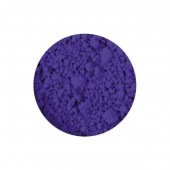
Ultramarine Blue Dark Pigment
Starting at: £4.00
PB29
Ultramarine Blue Dark is an artificial mineral pigment that is produced by heating clay, soda, sulphur and coal to high temperatures. Its name comes from outremer, or over-the-sea, as a reference to the highly-prized Lapis Lazuli pigment which had been imported into Europe from Afghanistan since the Middle Ages. First manufactured in France and Germany in 1828, synthetic Ultramarine provided a brilliant and affordable blue to artists, and it remains one of the most popular blues on artists' palettes today.
It is a transparent pigment, with a high tinting strength and excellent lightfastness. It reacts to alkali, therefore it is not suitable for use in lime-fresco; we do offer a Limeproof Ultramarine Blue for this purpose. It is stable in all other media, although it can be tricky to grind in oil. Instead of creating a thick, buttery paste, it can remain stringy and deteriorate when stored in a tube. To correct this, many commercial paint manufacturers include additives and waxes in their recipes; if you intend on grinding your own paint, you could try replacing 10-15% of your Linseed Oil with Poppy Oil to improve the consistency. Ultramine Blue provides a slow-drying, fairly hard paint film, which can tend towards brittleness.
Toxicity: B
Learn More -
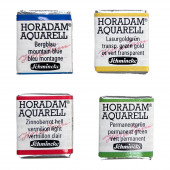
Schmincke Artists Watercolour Half Pan
Starting at: £6.05
Finest quality watercolours made in Germany. This range offers 139 colours, including 95 single-pigment colours, 3 perylene pigments, 5 quinacridone pigments, and a selection of granulating colours. They present endless mixing possibilities, and can combined with Schmincke's selection of watercolour mediums as well as with their gouache paints. The solid colours are produced by pouring the liquid paint into the pans four times, ensuring the maximum yield for each colour. Also available in whole pans and tubes of 5 and 15ml. Learn More -
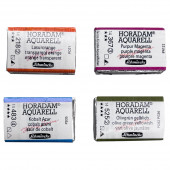
Schmincke Artists Watercolour Whole Pan
Starting at: £7.95
Finest quality watercolours made in Germany. This range offers 139 colours, including 95 single-pigment colours, 3 perylene pigments, 5 quinacridone pigments, and a selection of granulating colours. They present endless mixing possibilities, and can combined with Schmincke's selection of watercolour mediums as well as with their gouache paints. The solid colours are produced by pouring the liquid paint into the pans four times, ensuring the maximum yield for each colour. Also available in half pans and tubes of 5 and 15ml. Learn More -
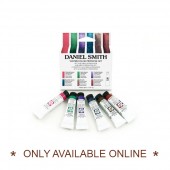
Daniel Smith Watercolour PrimaTek Set
£42.10Daniel Smith PrimaTek colours are unique paints made with pure, authentic mineral pigments that are mined directly from the earth and each one has a story. These colours have captured the imagination of artists for hundreds or even thousands of years. Their diversity is amazing. *Please note, this product is stored offsite. Please allow extra time for your order to be processed and dispatched. Learn More -
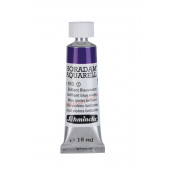
Schmincke Horadam Aquarell, Artists' Watercolour, 15 ml Tube
Starting at: £12.65
Finest quality watercolours made in Germany. This range offers 139 colours, including 95 single-pigment colours, 3 perylene pigments, 5 quinacridone pigments, and a selection of granulating colours. They present endless mixing possibilities, and can combined with Schmincke's selection of watercolour mediums as well as with their gouache paints. The solid colours are produced by pouring the liquid paint into the pans four times, ensuring the maximum yield for each colour. Also available in half and whole pans and 5ml tubes. Learn More -
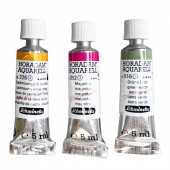
Schmincke Artists Watercolour 5 ml Tube
Starting at: £6.35
Finest quality watercolours made in Germany. This range offers 139 colours, including 95 single-pigment colours, 3 perylene pigments, 5 quinacridone pigments, and a selection of granulating colours. They present endless mixing possibilities, and can combined with Schmincke's selection of watercolour mediums as well as with their gouache paints. The solid colours are produced by pouring the liquid paint into the pans four times, ensuring the maximum yield for each colour. Also available in half and whole pans and 15ml tubes. Learn More -
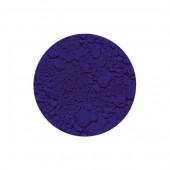
Ultramarine Blue Light Pigment
Starting at: £6.00
PB29
Ultramarine Blue Light is an artificial mineral pigment that is produced by heating clay, soda, sulphur and coal to high temperatures. Its name comes from outremer, or over-the-sea, as a reference to the highly-prized Lapis Lazuli pigment which had been imported into Europe from Afghanistan since the Middle Ages. First manufactured in France and Germany in 1828, synthetic Ultramarine provided a brilliant and affordable blue to artists, and it remains one of the most popular blues on artists' palettes today.
It is a transparent pigment, with a high tinting strength and excellent lightfastness. It reacts to alkali, therefore it is not suitable for use in lime-fresco; we do offer a Limeproof Ultramarine Blue for this purpose. It is stable in all other media, although it can be tricky to grind in oil. Instead of creating a thick, buttery paste, it can remain stringy and deteriorate when stored in a tube. To correct this, many commercial paint manufacturers include additives and waxes in their recipes; if you intend on grinding your own paint, you could try replacing 10-15% of your Linseed Oil with Poppy Oil to improve the consistency. Ultramine Blue provides a slow-drying, fairly hard paint film, which can tend towards brittleness.
Toxicity B
Learn More -
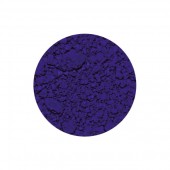
Ultramarine Blue Limewash Pigment
Starting at: £6.30
PB29
Ultramarine Blue Limewash is an artificial mineral pigment that is produced by heating clay, soda, sulphur and coal to high temperatures. Its name comes from outremer, or over-the-sea, as a reference to the highly-prized Lapis Lazuli pigment which had been imported into Europe from Afghanistan since the Middle Ages. First manufactured in France and Germany in 1828, synthetic Ultramarine provided a brilliant and affordable blue to artists, and it remains one of the most popular blues on artists' palettes today.
It is a transparent pigment, with a high tinting strength and excellent lightfastness. Most Ultramarine colours react to alkali and are therefore unsuitable for use in lime-fresco; Limeproof Ultramarine Blue remedies this problem. It is stable in all other media, although it can be tricky to grind in oil. Instead of creating a thick, buttery paste, it can remain stringy and deteriorate when stored in a tube. To correct this, many commercial paint manufacturers include additives and waxes in their recipes; if you intend on grinding your own paint, you could try replacing 10-15% of your Linseed Oil with Poppy Oil to improve the consistency. Ultramine Blue provides a slow-drying, fairly hard paint film, which can tend towards brittleness.
Toxicity: B
Learn More -
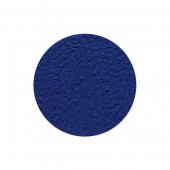
Ultramarine PB29 Pigment
Starting at: £9.10
PB29
Ultramarine Blue is an artificial mineral pigment that is produced by heating clay, soda, sulphur and coal to high temperatures. Its name comes from outremer, or over-the-sea, as a reference to the highly-prized Lapis Lazuli pigment which had been imported into Europe from Afghanistan since the Middle Ages. First manufactured in France and Germany in 1828, synthetic Ultramarine provided a brilliant and affordable blue to artists, and it remains one of the most popular blues on artists' palettes today.
It is a transparent pigment, with a high tinting strength and excellent lightfastness. It reacts to alkali, therefore it is not suitable for use in lime-fresco; we do offer a Limeproof Ultramarine Blue for this purpose. It is stable in all other media, although it can be tricky to grind in oil. Instead of creating a thick, buttery paste, it can remain stringy and deteriorate when stored in a tube. To correct this, many commercial paint manufacturers include additives and waxes in their recipes; if you intend on grinding your own paint, you could try replacing 10-15% of your Linseed Oil with Poppy Oil to improve the consistency. Ultramine Blue provides a slow-drying, fairly hard paint film, which can tend towards brittleness.
Toxicity: B/C
Learn More -
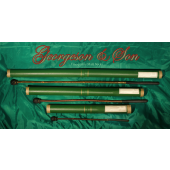
Georgeson & Son Mahl Sticks
Starting at: £26.00
Each Hazel shaft used in the creation of our Mahl poles is individually selected for straightness and overall appearance before being dried and prepared. We use hazel for strength, weight, and the appearance of its rich brown bark when linseed is applied.
Our pommels and handles are made from a stock of fine Italian leather, used for its durability and flex during assembly.
"Georgeson and Son established in 2012 with a singular aim. To resurrect and manufacture forgotten Artist's tools by hand, as carefully and as beautifully as possible.
A desire to make useful things that will last underpins all that we do. We use only the finest quality materials, sustainably sourced and refuse to compromise this quality for the sake of profitability."
Learn More -
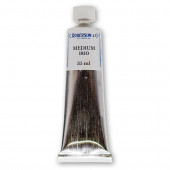
Roberson 1810 Medium
Starting at: £34.20
This is a traditional, high-oil "fat" painting medium, made using the highest quality materials. It will retain colour strength, is resistant to bleeding, has good flow release, is ideal for blending, and can be mixed with oil colours in any ratio. When dry, it creates an enamel-like surface.
Contains: Stand oil, Cold-pressed Linseed oil, Canada Balsam, Rectified Spirit of Turpentine, Beeswax, Driers.
Clean tools in white spirit. Do not use as a varnish, always mix with oil colour.
Learn More -
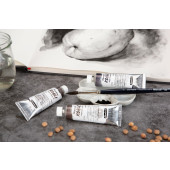
Schmincke Liquid Charcoal 15 ml
Starting at: £18.30
Liquid charcoal in the 15 ml tube - a clean, dust-free way of painting, charcoal drawing and underpainting with charcoal. The three pigments of natural origin used for this (PBK 8, pit black) are created by charring fruit seeds from the EU area and result in the following unique coal nuances: a neutral peach stone black - 18 757 a warm, brownish cherry pit black - 18 756 a cool, bluish grape seed black - 18 755 Due to the larger quantity of available paint, liquid charcoal can be used to quickly process large areas. The liquid charcoal contains the high-quality binder gum Arabic like traditional artists' watercolours (gouaches, watercolours, etc.), has a gouache-like consistency and can be diluted with water, so that different shades, structures and layer thicknesses can be achieved by different application. Depending on the substrate and the thickness of the layer, it can be wiped off by hand and removed with water. Used as thin underpainting (e.g. in oil painting), subsequent paints do not become dirty or become less dirty than with conventional charcoal underpainting due to the higher adhesion of the bound carbon pigments to the substrate. Of course, the liquid charcoal can be combined with drawing charcoal. The blurring and removability of the liquid charcoal depends on the surface of the substrate - the more even and firm the surface, the easier to change the application. Pre-tests are recommended. Learn More -
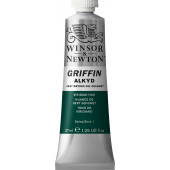
Winsor & Newton Griffin Alkyd Oil Colour
Starting at: £7.15
Artist quality range of 50 colours made from pigments bound in an oil modified alkyd resin. The main advantage of the Griffin Alkyd range is speed of drying - about 24 hours. Ideal for under painting. Compatible with traditional oils. Learn More -
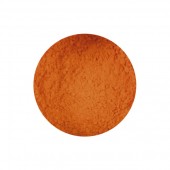
Lead Red Pigment (Minium)
Starting at: £7.30
Call to Order
PR105
Lead Red is an early articficial pigment that dates back to antiquity. It is created by heating Lead White or Litharge at a constant temperature of 480ºC over a prolonged period of time. It is a fast-drying colour, with good tinting strength and opacity, and has been widely used as an underpaint for gilding and in industry. However, it is highly toxic and generally unstable, so has fallen out of use in favour of Cadmium pigments. The acid in linseed oil causes Lead Red to darken, and it can solidify when stored in a tube. In water-based mediums, it can turn black.
Toxicity D Lead is a highly poisonous metal which, if inhaled, ingested, or introduced to the blood through cuts in the skin, builds up in the body and can affect multiple parts of the body, including the digestive and nervous systems.
PERMITTED USES Over 18s only. Proof of age required. Restoration of art works and protected buildings when alternatives unsuitable.
IMPORTANT Please refer to the MSDS (Material Safety Data Sheet) below. Dispose of product as hazardous waste.
SHIPPING Please note, we are not able to send this product outside the UK.
Learn More



